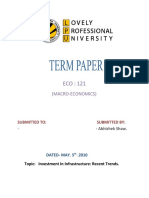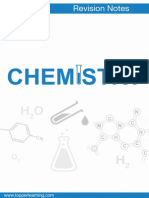2021-2022 SPRING TERM Chem 352 Physical Chemistry Ii 4/3/2022 Problem Set I
2021-2022 SPRING TERM Chem 352 Physical Chemistry Ii 4/3/2022 Problem Set I
Uploaded by
kittyngameCopyright:
Available Formats
2021-2022 SPRING TERM Chem 352 Physical Chemistry Ii 4/3/2022 Problem Set I
2021-2022 SPRING TERM Chem 352 Physical Chemistry Ii 4/3/2022 Problem Set I
Uploaded by
kittyngameOriginal Title
Copyright
Available Formats
Share this document
Did you find this document useful?
Is this content inappropriate?
Copyright:
Available Formats
2021-2022 SPRING TERM Chem 352 Physical Chemistry Ii 4/3/2022 Problem Set I
2021-2022 SPRING TERM Chem 352 Physical Chemistry Ii 4/3/2022 Problem Set I
Uploaded by
kittyngameCopyright:
Available Formats
2021-2022 SPRING TERM
CHEM 352 PHYSICAL CHEMISTRY II 4/3/2022
PROBLEM SET I
1- 3.00 moles of an ideal gas at 27.0ºC expands isothermally from an initial volume of 20.0 dm 3 to a
final volume of 60.0 dm3. Calculate w for this process a) for expansion against a constant external
pressure of 1.00 x 105 Pa, and b) for a reversible expansion.
2- For one mole of an ideal gas, Pexternal = 200 x 103 Pa. The temperature is changed from 100ºC to
25.0ºC at constant pressure. CV,m = 3/2 R. Calculate q, w, ΔU, and ΔH.
3- (Atkins Ed.8 2.3b) A sample consisting of 2.00 mol He is expanded isothermally at 22°C from 22.8
dm3 to 31.7 dm3 (a) reversibly, (b) against a constant external pressure equal to the final pressure
of the gas, and (c) freely (against zero external pressure). For the three processes calculate q, w,
ΔU, and ΔH.
4- A sample containing 2.00 mol of an ideal gas undergoes isothermal expansion along three different
paths:
(1) reversible expansion from Pi = 25.0 bar and Vi = 4.50 L to Pf=4.50 bar,
(2) a single-step irreversible expansion against a constant external pressure of 4.50 bar, and
(3) a two-step irreversible expansion consisting initially of an expansion against a constant pressure
of 11.0 bar until P=Pext, followed by an expansion against a constant external pressure of 4.50 bar
until P=Pext.
Calculate the work for each of these processes. For which of the irreversible processes is the
magnitude of the work greater?
5- (Atkins Ed.8 2.3b) The constant-pressure heat capacity of a sample of a perfect gas was found to
vary with temperature according to the expression Cp/(J K−1) =20.17 + 0.4001(T/K). Calculate q, w,
ΔU, and ΔH when the temperature is raised from 0°C to 100°C (a) at constant pressure, (b) at
constant volume.
𝑜
6- At 298K, Δ𝐻𝑟𝑒𝑎𝑐𝑡𝑖𝑜𝑛 =131.28 kJ/mol for the reaction C(graphite) + H2O →CO(g) + H2(g).
CP,m = 8.53, 33.58, 29.12, and 28.82 J/mol.K for graphite, H2O(g), CO(g), and H2(g),
respectively. Calculate reaction ΔHo at 125ºC from this information. Assume that the heat
capacities are independent of temperature.
7- From the following data at 25C
𝑜
½ H2(g) + ½ O2(g) → OH(g) Δ𝐻𝑟𝑒𝑎𝑐𝑡𝑖𝑜𝑛 = 38.95 kJ/mol
𝑜
H2(g) + ½ O2(g) → H2O(g) Δ𝐻𝑟𝑒𝑎𝑐𝑡𝑖𝑜𝑛 = –241.814 kJ/mol
𝑜
H2(g) → 2H(g) Δ𝐻𝑟𝑒𝑎𝑐𝑡𝑖𝑜𝑛 = 435.994 kJ/mol
𝑜
O2(g) → 2O (g) Δ𝐻𝑟𝑒𝑎𝑐𝑡𝑖𝑜𝑛 = 498.34 kJ/mol
𝑜
Calculate , Δ𝐻𝑟𝑒𝑎𝑐𝑡𝑖𝑜𝑛 for
a) OH (g) → H(g) + O(g)
b) H2O(g) → 2H(g) + O(g)
c) H2O(g) → H(g) + OH(g)
𝑜 𝑜
Assuming ideal gas behavior, calculate Δ𝐻𝑟𝑒𝑎𝑐𝑡𝑖𝑜𝑛 and Δ𝑈𝑟𝑒𝑎𝑐𝑡𝑖𝑜𝑛 for all three reactions.
You might also like
- The Subtle Art of Not Giving a F*ck: A Counterintuitive Approach to Living a Good LifeFrom EverandThe Subtle Art of Not Giving a F*ck: A Counterintuitive Approach to Living a Good LifeRating: 4 out of 5 stars4/5 (5891)
- Kris Gethins 12 Week Muscle Builder EbookDocument45 pagesKris Gethins 12 Week Muscle Builder Ebookadmsoutheast100% (6)
- The Gifts of Imperfection: Let Go of Who You Think You're Supposed to Be and Embrace Who You AreFrom EverandThe Gifts of Imperfection: Let Go of Who You Think You're Supposed to Be and Embrace Who You AreRating: 4 out of 5 stars4/5 (1103)
- Never Split the Difference: Negotiating As If Your Life Depended On ItFrom EverandNever Split the Difference: Negotiating As If Your Life Depended On ItRating: 4.5 out of 5 stars4.5/5 (870)
- Grit: The Power of Passion and PerseveranceFrom EverandGrit: The Power of Passion and PerseveranceRating: 4 out of 5 stars4/5 (597)
- Hidden Figures: The American Dream and the Untold Story of the Black Women Mathematicians Who Helped Win the Space RaceFrom EverandHidden Figures: The American Dream and the Untold Story of the Black Women Mathematicians Who Helped Win the Space RaceRating: 4 out of 5 stars4/5 (912)
- Shoe Dog: A Memoir by the Creator of NikeFrom EverandShoe Dog: A Memoir by the Creator of NikeRating: 4.5 out of 5 stars4.5/5 (543)
- The Hard Thing About Hard Things: Building a Business When There Are No Easy AnswersFrom EverandThe Hard Thing About Hard Things: Building a Business When There Are No Easy AnswersRating: 4.5 out of 5 stars4.5/5 (352)
- Elon Musk: Tesla, SpaceX, and the Quest for a Fantastic FutureFrom EverandElon Musk: Tesla, SpaceX, and the Quest for a Fantastic FutureRating: 4.5 out of 5 stars4.5/5 (474)
- Her Body and Other Parties: StoriesFrom EverandHer Body and Other Parties: StoriesRating: 4 out of 5 stars4/5 (830)
- The Sympathizer: A Novel (Pulitzer Prize for Fiction)From EverandThe Sympathizer: A Novel (Pulitzer Prize for Fiction)Rating: 4.5 out of 5 stars4.5/5 (122)
- The Little Book of Hygge: Danish Secrets to Happy LivingFrom EverandThe Little Book of Hygge: Danish Secrets to Happy LivingRating: 3.5 out of 5 stars3.5/5 (414)
- The Emperor of All Maladies: A Biography of CancerFrom EverandThe Emperor of All Maladies: A Biography of CancerRating: 4.5 out of 5 stars4.5/5 (272)
- The Yellow House: A Memoir (2019 National Book Award Winner)From EverandThe Yellow House: A Memoir (2019 National Book Award Winner)Rating: 4 out of 5 stars4/5 (99)
- The World Is Flat 3.0: A Brief History of the Twenty-first CenturyFrom EverandThe World Is Flat 3.0: A Brief History of the Twenty-first CenturyRating: 3.5 out of 5 stars3.5/5 (2270)
- Devil in the Grove: Thurgood Marshall, the Groveland Boys, and the Dawn of a New AmericaFrom EverandDevil in the Grove: Thurgood Marshall, the Groveland Boys, and the Dawn of a New AmericaRating: 4.5 out of 5 stars4.5/5 (269)
- Team of Rivals: The Political Genius of Abraham LincolnFrom EverandTeam of Rivals: The Political Genius of Abraham LincolnRating: 4.5 out of 5 stars4.5/5 (235)
- A Heartbreaking Work Of Staggering Genius: A Memoir Based on a True StoryFrom EverandA Heartbreaking Work Of Staggering Genius: A Memoir Based on a True StoryRating: 3.5 out of 5 stars3.5/5 (232)
- On Fire: The (Burning) Case for a Green New DealFrom EverandOn Fire: The (Burning) Case for a Green New DealRating: 4 out of 5 stars4/5 (74)
- O Level Biology Practice Questions And Answers EnzymesFrom EverandO Level Biology Practice Questions And Answers EnzymesRating: 5 out of 5 stars5/5 (1)
- The Unwinding: An Inner History of the New AmericaFrom EverandThe Unwinding: An Inner History of the New AmericaRating: 4 out of 5 stars4/5 (45)
- A Modern Course in Statistical PhysicsFrom EverandA Modern Course in Statistical PhysicsRating: 3.5 out of 5 stars3.5/5 (2)
- Practice Makes Perfect in Chemistry: Oxidation-ReductionFrom EverandPractice Makes Perfect in Chemistry: Oxidation-ReductionRating: 5 out of 5 stars5/5 (1)
- Carbon Dioxide Thermodynamic Properties Handbook: Covering Temperatures from -20° to 250°C and Pressures up to 1000 BarFrom EverandCarbon Dioxide Thermodynamic Properties Handbook: Covering Temperatures from -20° to 250°C and Pressures up to 1000 BarNo ratings yet
- Practice Makes Perfect in Chemistry: The Physical Behavior of MatterFrom EverandPractice Makes Perfect in Chemistry: The Physical Behavior of MatterRating: 5 out of 5 stars5/5 (1)
- Practice Makes Perfect in Chemistry: Oxidation-Reduction with AnswersFrom EverandPractice Makes Perfect in Chemistry: Oxidation-Reduction with AnswersNo ratings yet
- Global Warming Temperatures and Projections: As Related to CO2 and H2O Absorptions, H2O Evaporation, and Post-Condensation ConvectionFrom EverandGlobal Warming Temperatures and Projections: As Related to CO2 and H2O Absorptions, H2O Evaporation, and Post-Condensation ConvectionNo ratings yet
- Practice Makes Perfect in Chemistry: The Physical Behavior of Matter with AnswersFrom EverandPractice Makes Perfect in Chemistry: The Physical Behavior of Matter with AnswersNo ratings yet
- Gas Hydrates 1: Fundamentals, Characterization and ModelingFrom EverandGas Hydrates 1: Fundamentals, Characterization and ModelingDaniel BrosetaNo ratings yet
- “Foundations to Flight: Mastering Physics from Curiosity to Confidence: Cipher 4”: “Foundations to Flight: Mastering Physics from Curiosity to Confidence, #4From Everand“Foundations to Flight: Mastering Physics from Curiosity to Confidence: Cipher 4”: “Foundations to Flight: Mastering Physics from Curiosity to Confidence, #4Rating: 5 out of 5 stars5/5 (1)
- Physico-Chemistry of Solid-Gas Interfaces: Concepts and Methodology for Gas Sensor DevelopmentFrom EverandPhysico-Chemistry of Solid-Gas Interfaces: Concepts and Methodology for Gas Sensor DevelopmentNo ratings yet
- Synthetic Natural Gas: From Coal, Dry Biomass, and Power-to-Gas ApplicationsFrom EverandSynthetic Natural Gas: From Coal, Dry Biomass, and Power-to-Gas ApplicationsTilman J. SchildhauerNo ratings yet
- Analytical Modeling of Solute Transport in Groundwater: Using Models to Understand the Effect of Natural Processes on Contaminant Fate and TransportFrom EverandAnalytical Modeling of Solute Transport in Groundwater: Using Models to Understand the Effect of Natural Processes on Contaminant Fate and TransportNo ratings yet
- Thermodynamic analysis of geothermal heat pumps for civil air-conditioningFrom EverandThermodynamic analysis of geothermal heat pumps for civil air-conditioningRating: 5 out of 5 stars5/5 (2)
- Treatise on Irreversible and Statistical Thermodynamics: An Introduction to Nonclassical ThermodynamicsFrom EverandTreatise on Irreversible and Statistical Thermodynamics: An Introduction to Nonclassical ThermodynamicsRating: 1 out of 5 stars1/5 (1)
- Gas Hydrates 2: Geoscience Issues and Potential Industrial ApplicationsFrom EverandGas Hydrates 2: Geoscience Issues and Potential Industrial ApplicationsLivio RuffineNo ratings yet
- How Dare You Greta ThunbergDocument2 pagesHow Dare You Greta Thunberga.kyrousiNo ratings yet
- Bhanjyang Book 2071-2Document208 pagesBhanjyang Book 2071-2KesharKhulalNo ratings yet
- Daihatsu Charade 1992Document22 pagesDaihatsu Charade 1992Mac Pirx100% (1)
- Infrastructure Recent TrendsDocument16 pagesInfrastructure Recent TrendsArchit SharmaNo ratings yet
- Maths BookletDocument56 pagesMaths BookletRachita SinghNo ratings yet
- Electronics Study Material For MSCDocument23 pagesElectronics Study Material For MSCiswaleha100% (1)
- Exercise 6Document9 pagesExercise 6bon ruel LegaspinaNo ratings yet
- apilarinos,+207+Times+Up+searchable Part23Document20 pagesapilarinos,+207+Times+Up+searchable Part23manosNo ratings yet
- PLC Interview QuestionsDocument2 pagesPLC Interview QuestionsSushant100% (1)
- ShipyardsDocument27 pagesShipyardsimran5705074No ratings yet
- Icp Das Usa Price List 061012Document25 pagesIcp Das Usa Price List 061012Andi AhmadNo ratings yet
- The Snow GooseDocument6 pagesThe Snow GooseEfan Hafiidh AdrianNo ratings yet
- AI MCQ Pharma (Lec1)Document8 pagesAI MCQ Pharma (Lec1)raneemalnaamnehNo ratings yet
- Cyflow Counter: The Complete Solution For Hiv/Aids MonitoringDocument12 pagesCyflow Counter: The Complete Solution For Hiv/Aids MonitoringDinesh SreedharanNo ratings yet
- PROVEDVENDORLISTREV08 NewFromPOGCDocument159 pagesPROVEDVENDORLISTREV08 NewFromPOGChk168No ratings yet
- 2014 Delphi Training CurriculumDocument20 pages2014 Delphi Training CurriculumDerek Jewett100% (2)
- Revision Notes For Class 12 CBSE Chemistry, Chemistry in Everyday Life - TopperlearningDocument8 pagesRevision Notes For Class 12 CBSE Chemistry, Chemistry in Everyday Life - TopperlearningRishabh Bhandari100% (1)
- Cement PlantDocument232 pagesCement PlantAnonymous iI88Lt100% (1)
- G Me 160 PDFDocument70 pagesG Me 160 PDFHamid AbbasiNo ratings yet
- Cumulative Skills Units 1 10 A Answer Key Audio ScriptDocument2 pagesCumulative Skills Units 1 10 A Answer Key Audio ScriptMeyirbek AbdikadirovNo ratings yet
- Thesis About School CafeteriaDocument4 pagesThesis About School CafeteriaCollegePapersToBuySingapore100% (2)
- Design of Knuckle JointDocument26 pagesDesign of Knuckle Jointvikasporwal2605100% (2)
- AdvancesDocument53 pagesAdvancesJuan Carlos MontielNo ratings yet
- Chem 331 Quiz KeysDocument4 pagesChem 331 Quiz KeysJacob HorgerNo ratings yet
- SPD eRAN7.0 CA Feature Introduction-20140228-A-1.0Document32 pagesSPD eRAN7.0 CA Feature Introduction-20140228-A-1.0KhanNo ratings yet
- CHPT 4Document54 pagesCHPT 4Yahya Faiez Waqqad0% (1)
- Testing Lab Manual-2FinalDocument106 pagesTesting Lab Manual-2FinalYonas NigussieNo ratings yet
- 2020 03 Maintworld AdashDocument2 pages2020 03 Maintworld AdashaabejaroNo ratings yet
- LNGC Golar Frost - IMO 9253284 - Machinery Operating ManualDocument421 pagesLNGC Golar Frost - IMO 9253284 - Machinery Operating Manualseawolf50No ratings yet




























































































































